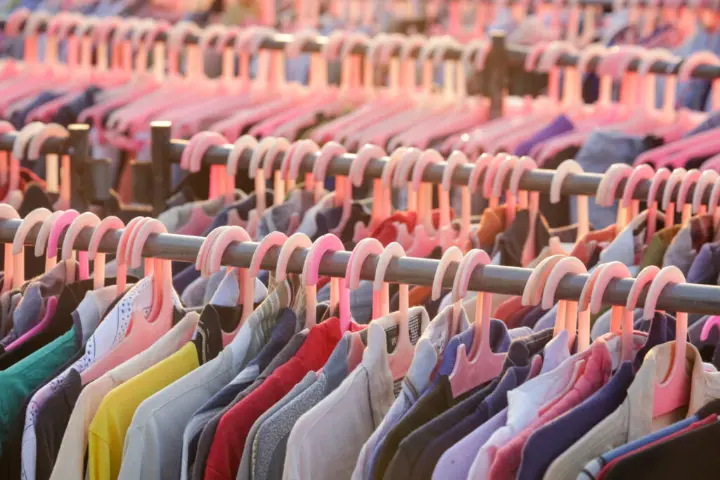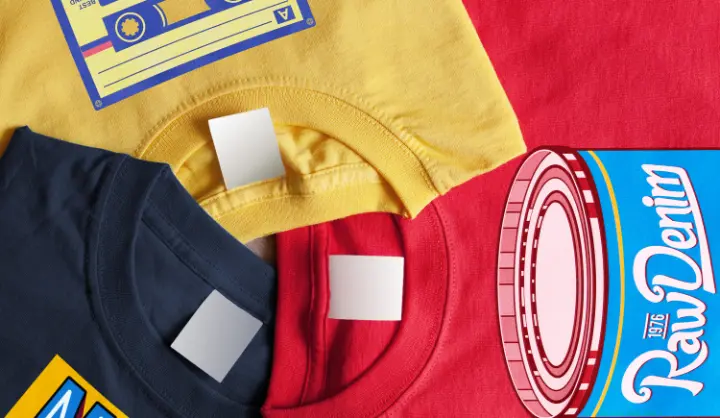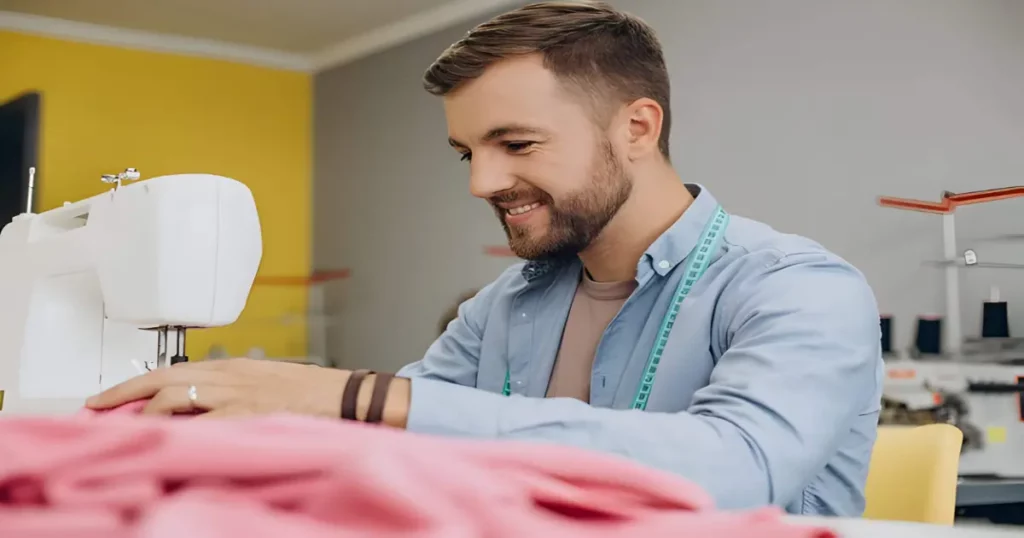No products in the cart.
Blog
Big Question: How Much Does It Cost To Make A Shirt?
When it comes to creating shirts, whether for use or to launch your own clothing line, understanding how much does it cost to make a shirt is essential. Several key elements can influence the final price of manufacturing it.
In this article, we will break down these factors and provide you with valuable insights into the cost of making a shirt.
How Much Does It Cost To Make A Shirt?

The way of how much does it cost to make a shirt can vary significantly based on several factors. These include order quantity, shirts’ quality, type of fabric, print location, the number of ink hues, shirt dimensions, and other considerations like the refund period and date of receipt.
Generally, the larger the order quantity, the lower the cost per shirt. Higher-quality shirts and specialized fabrics can increase costs, as can complex designs with multiple print locations and ink hues. Careful planning and budgeting how much does it cost to make a shirt are essential to determine the specific cost of making a shirt for your unique production needs and target market.
The cost of manufacturing shirts can be broken down into various components, and each of these components can be quantified to provide a clearer picture of the expenses involved.
Materials
The cost of materials is a significant factor in shirt production. For instance, the price of fabric per yard or meter can vary widely. A typical shirt might require about 1.5 to 2 yards of fabric. Let’s assume that you are using standard cotton fabric, and it costs $5 per yard. In this case, the material cost for one shirt would be approximately $7.50 to $10.
Labor
Labor costs can be calculated based on hourly wages and the time required to produce one shirt. If a skilled worker can produce 10 shirts in an hour and earns $15 per hour, then the labor cost per shirt would be $1.50.
Overhead Costs
Overhead costs, such as rent, utilities, and equipment maintenance, can vary widely depending on the scale of your operation. Let’s assume your monthly overhead expenses amount to $2,000, and you produce 1,000 shirts per month. In this case, the overhead cost per shirt would be $2.
Customization
If you plan to customize your shirts with a logo or design, the cost can be determined based on the chosen customization method. For example, screen printing might cost $2 per shirt, and embroidery could cost $4 per shirt.
Quantity
The quantity of shirts you produce also affects the overall cost. Larger production runs typically result in lower per-unit costs. Let’s say you produce 100 shirts at a time. This would spread the overhead costs more thinly, reducing the per-shirt overhead cost from $2 to $0.20.
Now, let’s calculate the total cost per shirt based on the above assumptions:
Material cost: $7.50 to $10
Labor cost: $1.50
Overhead cost: $0.20 (assuming a production quantity of 100)
Customization cost (screen printing): $2
Total cost (minimum): $11.20 (with lower material cost)
Total cost (maximum): $13.70 (with higher material cost)
Factors Influencing the Cost of Making a Shirt

Order Quantity
Order quantity is a pivotal factor that can significantly affect the way how much does it cost to make a shirt. Essentially, it refers to the number of shirts you plan to produce in a single order or production run.
Manufacturers often offer attractive bulk discounts, which means that the more shirts you order at once, the lower the cost per individual one. This is because producing in larger quantities allows manufacturers to optimize their production processes, reduce setup costs, and minimize material wastage.
Therefore, if you’re looking how much does it cost to make a shirt and maximize your budget, it’s advisable to consider ordering in larger quantities. However, it’s crucial to strike the right balance between order quantity and demand to avoid overproduction and potential excess inventory costs.
Careful planning and market research can help you determine the optimal order quantity for your specific needs and target market, ensuring cost-effectiveness while minimizing unnecessary expenses.
Shirts’ Quality
The quality of the shirts you choose to manufacture is a fundamental factor that greatly influences the overall cost of production. They are available in a wide range of quality levels, from basic, low-cost options to premium, high-end garments.
The quality is determined by various factors, including the choice of materials, construction methods, and attention to detail in the manufacturing process.
High-quality shirts are often made from superior materials, such as fine cotton or blends with advanced features like moisture-wicking properties, enhanced durability, and superior comfort. These premium materials typically come at a higher cost compared to basic fabrics.
Additionally, the manufacturing process for high-quality shirts may involve more intricate stitching, better finishing, and additional quality control measures, all of which contribute to a higher cost per shirt. The decision how much does it cost to make a shirt of higher quality or more basic options should align with your target market’s expectations and budget.
Balancing quality and cost is essential to meet your customers’ needs while ensuring your pricing remains competitive in the market. Remember that investing in higher-quality can lead to greater customer satisfaction, repeat business, and a stronger brand reputation, which may justify the higher initial manufacturing costs.
Type Of Fabric

The choice of fabric is a critical factor that significantly impacts the cost of making shirts. Shirts can be made from a wide variety of materials, each with its unique characteristics and associated costs. One of the most common fabrics used for it is cotton, known for its comfort, breathability, and versatility.
However, within the category of cotton alone, there are various options such as regular cotton, organic cotton, and premium cotton blends. Organic cotton, for instance, is grown without synthetic pesticides or fertilizers, making it an environmentally friendly but slightly more expensive choice.
Premium cotton blends often include features like stretch, wrinkle resistance, or enhanced durability, which can also raise production costs. Beyond cotton, other fabric choices such as bamboo, linen, or performance synthetics offer different benefits but may come at a higher price point.
The fabric you choose not only affects the cost but also the overall feel, appearance, and performance of it. It’s essential to strike the right balance between fabric quality and cost to cater to your target market’s preferences and budget while ensuring that your shirts meet the desired level of comfort and functionality.
Moreover, the type of fabric can also impact the ease of printing and the quality of the printed design, making it an important consideration when planning your production.
Print Location
The print location on how much does it cost to make a shirt is a crucial aspect that can significantly affect the cost of production. When creating custom shirts, the placement of the design or logo plays a key role in determining the overall cost. The more elaborate and intricate the design or the more locations you want to print on it, the higher the production costs will be.
Shirts can have prints on various areas, including the front, back, sleeves, pockets, and even the collar. Each additional print location requires separate setup and printing processes, which often involve additional labor, materials, and time.
Moreover, complex designs with multiple colors or gradients may also increase the cost, as they demand precise printing techniques and more ink. To optimize costs, it’s essential to carefully consider your design and its placement.
Balancing your creative vision with your budget is crucial, as you want to deliver an appealing product to your customers while keeping production expenses manageable.
Discussing your printing options and design choices with your manufacturer can help you determine how much does it cost to make a shirt and the most cost-effective approach that meets your specific requirements and ensures the desired quality of the printing.
Calculating the Cost
Calculating how much does it cost to make a shirt making it involves a comprehensive evaluation of various elements, ensuring that you have a clear understanding of your expenses and can set competitive pricing. It begins with a tailored approach that breaks down the costs into distinct categories.
Firstly, there’s the cost of materials, which includes the fabric, with factors like the type and quality of the fabric playing a significant role in determining this expense.
Secondly, you need to considerhow much does it cost to make a shirt of printing, which depends on the complexity of your design, the number of ink hues, and the print locations. The more intricate your design or the more colors involved, the higher the printing costs will be.
Thirdly, labor costs encompass the expenses associated with cutting, sewing, and assembling each shirt. These costs can vary depending on the location of the manufacturing facility and the level of expertise required. Additionally, overheads, such as shipping, taxes, and other miscellaneous expenses, should be factored into your calculations.
Lastly, it’s vital to include a profit margin to ensure your business remains financially sustainable. Determining an appropriate profit margin depends on various factors, including your market positioning, target audience, and business goals.
By following this systematic approach and carefully assessing each cost component, you can arrive at a comprehensive understanding of the total expenses involved in making shirts.
This knowledge empowers you to make informed decisions about pricing, production quantities, and design choices, ultimately helping your clothing business thrive in a competitive market.
A Tailoring Approach
One approach to calculating how much does it cost to make a shirt is to break it down into a series of steps:
- Materials: Start with the cost of the fabric per shirt, factoring in the type and quality of the material.
- Printing: Determine the cost of printing per shirt based on the number of ink hues, print locations, and intricacy of the design.
- Labor: Consider the labor cost involved in cutting, sewing, and assembling each shirt.
- Overheads: Include any additional costs such as shipping, taxes, and overhead expenses associated with running your clothing business.
- Profit Margin: Finally, add your desired profit margin to ensure your business remains sustainable and profitable.
The Number Of Ink Hues

The number of ink hues used in its design is a critical factor that directly impacts the cost of production. When creating custom shirts, the choice of colors in your design can significantly affect the complexity of the printing process and, consequently, the overall expense.
Simple designs with just one or two ink hues are generally more cost-effective to produce, as they require less setup and printing time. On the other hand, complex and colorful designs with multiple ink hues can lead to increased costs. Each additional color in your design necessitates separate printing plates, setup, and careful alignment during the printing process.
This not only adds to the material and labor costs but also requires more time and attention to detail. Additionally, precise color matching and registration become crucial with multi-hued designs to ensure the final print looks accurate and vibrant.
While vibrant and intricate designs can be visually appealing and captivating, they can also inflate production costs. It’s essential to strike a balance between your creative vision and your budget, carefully considering how much does it cost to make a shirt and the impact of the number of ink hues on both cost and the overall aesthetics of your custom one.
Engaging in discussions with your manufacturer about cost-effective printing techniques and color choices can help you make informed decisions that align with your production goals and budget constraints.
Shirt Dimensions
Shirt dimensions are another crucial factor that can significantly influence how much does it cost to make a shirt. The size and dimensions of a shirt directly impact the amount of fabric required for each shirt, as larger one naturally demand more material. This leads to higher material costs, which can escalate the overall production expenses.
Additionally, larger shirts may require adjustments in the cutting and sewing processes, potentially increasing labor costs as well. Therefore, when planning how much does it cost to make a shirt, it’s essential to carefully consider the range of sizes you intend to offer and their associated costs.
Balancing your size options to cater to a diverse customer base while managing expenses is key. It’s important to strike a balance between offering various sizes to accommodate different body types and preferences, while also ensuring that your budget remains manageable.
In doing so, you can optimize how much does it cost to make a shirt and provide a range of sizes that appeals to your target audience, ultimately contributing to the success of your shirt business.
Refund Period/Date Of Receipt
The refund period and the date of receipt are vital aspects to consider when calculating the cost of making shirts. While they may not be directly related to the manufacturing expenses, they play a significant role in your overall financial planning and business strategy.
The refund period, which refers to the timeframe within which customers can return or exchange their purchased shirts, is essential for managing potential post-production costs.
A generous refund policy can impact your bottom line, as it may lead to a higher number of returns or exchanges, potentially resulting in additional expenses related to restocking, handling, or even the disposal of returned items.
On the other hand, the date of receipt is crucial for inventory management and financial planning. It influences when you incur costs related to the manufacturing and storage of shirts, as well as when you anticipate receiving revenue from sales. A clear understanding of your expected date of receipt helps you manage cash flow, determine reorder points, and make informed decisions about production quantities.
Balancing your refund policy and the timing of receipts is essential to ensure the financial health of your clothing business. While a customer-friendly refund policy can enhance customer satisfaction and loyalty, it should be designed with careful consideration of its impact on your budget and operational efficiency.
Similarly, aligning the date of receipt with your production schedule and expenses helps you optimize your inventory management and financial planning, ensuring that you can meet customer demand while minimizing unnecessary costs. By effectively managing these aspects, you can contribute to the long-term success and profitability of your shirt business.
Conclusion
In conclusion, the cost of making a shirt is a multifaceted equation that depends on various factors. By understanding and carefully managing these elements, such as order quantity, shirt quality, fabric choice, print location, design complexity, shirt dimensions, and business policies, you can effectively calculate and control the cost of producing custom shirts. Ultimately, with thoughtful planning and informed decisions, you can create high-quality shirts that not only satisfy customers but also contribute to the financial sustainability of your clothing business.


